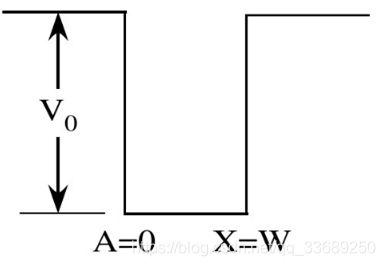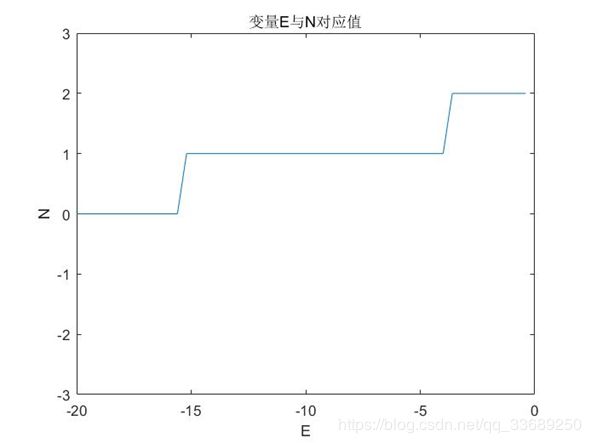一维方势阱中粒子能级和波函数matlab求解(定态薛定谔方程数值求解)
1.定态薛定谔方程
薛定谔方程为量子力学中的基本方程,其揭示微观世界物质运动基本规律、是原子物理学中处理一切非相对论问题的有力工具。本文利用基础计算机数值模拟方法对其能级、波函数等性质求解。
薛定谔方程通常表示:
若求能级与波函数,势函数不含时间,则代入下述方程:
得到定态不含时的薛定谔方程:
2.一维方势阱中粒子能级、波函数模拟求解
对于如图一维方势阱问题,其势函数为:
带入上述微分方程,其解为:
利用边界条件确定系数A,B,C,D
利用波函数连续性可得:
求得:
经过推导得到归一化的本征函数:
3.matlab数值计算
其计算流程图如下:
N=0;
V0=-20;
W=1.0;%势阱宽度
Emin=V0%势能
Emax=0;
M=51;%离散步长
de=(Emax-Emin)./(M-1);
E=Emin-de;
Ans=[];
for i=1:M-1
E=E+de;
r1=sqrt(abs(E-V0));
r2=sqrt(abs(E));
phi=(r2./r1)*sin(W*r1)+cos(W*r1);
phi1=(r2*cos(W*r1)-r1*sin(W*r1));
C1=0.5*(exp(-W*r2))*(phi+(phi1./r2));
D1=0.5*(exp(W*r2))*(phi-(phi1./r2));
N=floor((W*r1)./3.1415926);
if (N-floor(0.5*N)*2~=0&&phi>0)
N=N+1;
end
if (N-floor(0.5*N)*2==0&&phi<0)
N=N+1;
end
if C1*D1<0
if ((log(-D1./C1))./(2*r2))>W
N=N+1;
Ans(i,1)=E;
Ans(i,2)=N;
else
Ans(i,1)=E;
Ans(i,2)=N;
end
else
Ans(i,1)=E;
Ans(i,2)=N;
end
end
count=2;
n=[0];%N值量子数
E=[Emin];
for i=1:size(Ans(:,2),1)
if Ans(i,2)~=n(count-1)
n(count)=Ans(i,2);
E(count)=Ans(i,1);
count=count+1;
end
end
plot(n,E,'ro');
%ylim([-3,3]);
title('E与n对应值');
xlabel('n')
ylabel('E')计算结果如下:
表 变量E与N对应值
1
| E |
-20 |
… |
-15.6 |
-15.2 |
-14.8 |
… |
-4.0 |
-3.6 |
… |
-0.4 |
| N |
0 |
… |
0 |
1 |
1 |
… |
1 |
2 |
… |
2 |
波函数绘图
L1=5;
x=0:0.01:L1;%势阱宽度
z1=(sqrt(2./L1))*sin((1*pi*x)./L1);
z2=(sqrt(2./L1))*sin((2*pi*x)./L1);
z3=(sqrt(2./L1))*sin((3*pi*x)./L1);
subplot(3,2,1);
plot(x,z1.^2);
%hold onlegend('n=1','n=2','n=3')
legend('n=1')
title('波函数');
xlabel('势阱宽度')
ylabel('概率密度')
%hold onlegend('n=1','n=2','n=3')
%%%%%%%%%%%%
subplot(3,2,2);
plot(x,z1);
legend('n=1')
title('波函数');
xlabel('势阱宽度')
ylabel('|波函数|')
%%%%%%%%%%%%%%%%%%%%%%%
subplot(3,2,3);
plot(x,z2.^2);
legend('n=2')
title('波函数');
xlabel('势阱宽度')
ylabel('概率密度')
subplot(3,2,4);
plot(x,z2.^2);
legend('n=2')
title('波函数');
xlabel('势阱宽度')
ylabel('概率密度')
%%%%%%%%%%%%%
%hold on
subplot(3,2,5);
plot(x,z3.^2);
legend('n=3')
title('波函数');
xlabel('势阱宽度')
ylabel('概率密度')
subplot(3,2,6);
plot(x,z3.^2);
legend('n=3')
title('波函数');
xlabel('势阱宽度')
ylabel('|波函数')
%set(gca,'ytick',[],'ycolor','w')












